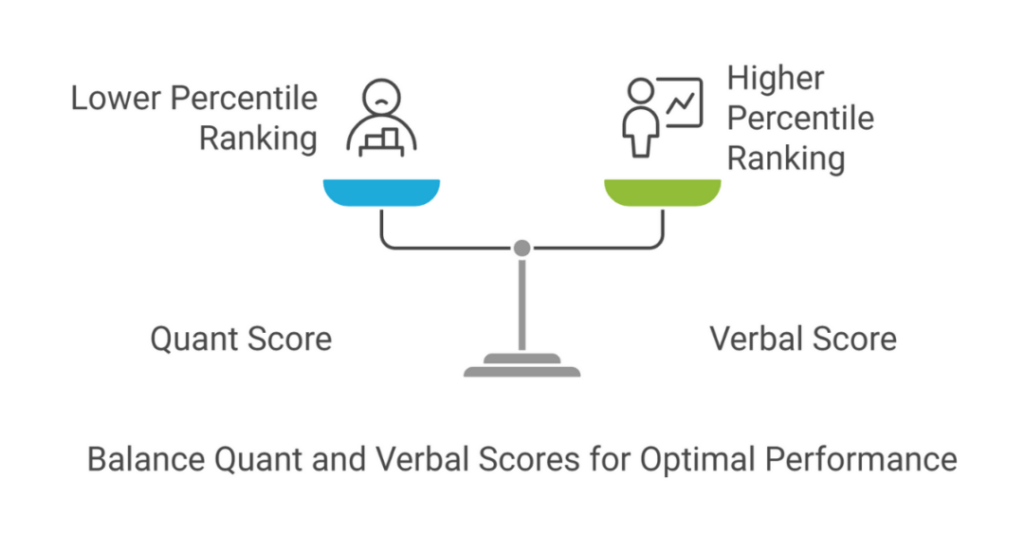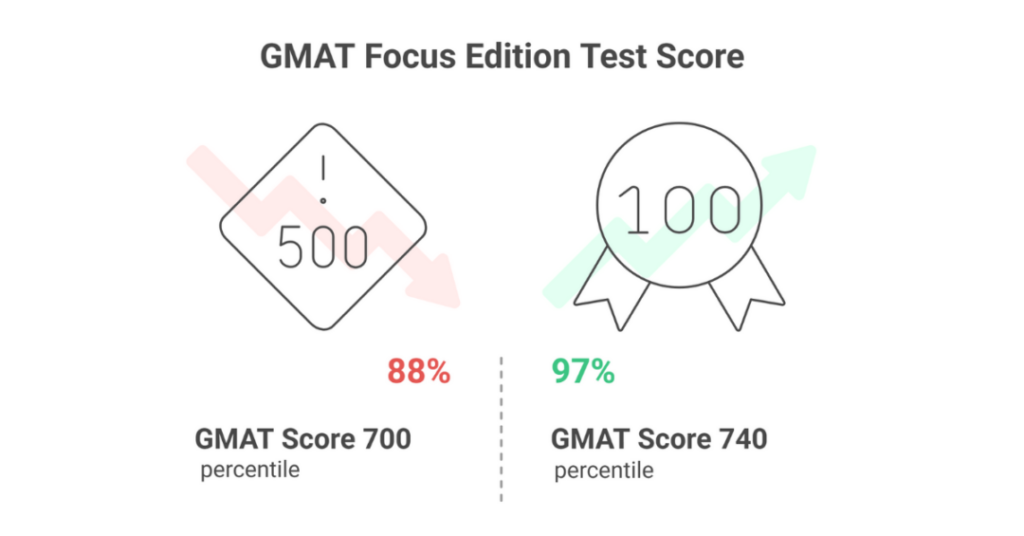19 May 2025
7 minutes read
How To Use The GMAT Score Chart Percentile In 2024 – 2025 as an Indian Student?

Key Takeaways
- GMAT score chart helps you understand how raw scores convert to scaled scores, making it easier to set realistic test goals and track progress.
- GMAT score chart provides a clear breakdown of section-wise scoring, helping you target areas to improve your overall performance strategically.
- GMAT score chart is a vital tool for comparing your performance against top B-school benchmarks and estimating your admissions competitiveness.
Do you know that a GMAT score of 740 puts you in the top 12% of test-takers? Have you ever been confused about what your mean GMAT percentile score is telling you? You’re not alone. Many students have been there, standing in front of their score reports thinking about how they compare to others on the GMAT scale.
The truth is, it’s all fairly confusing and stressful to translate GMAT exam pattern. You may be fretting about whether your average GMAT score, quant score, or verbal mark is sufficient for your ideal business school or is competitive with other candidates.
But don’t get too worked up—grasping the GMAT percentile chart will allow you to specifically know where you are and where to take action to increase your likelihood of admission to a great program into the top Universities in the USA.
The total score of the GMAT exam is 205-805, and being aware of your percentile-ranking in the most latest format of the GMAT, effective January 2024, can help you better understand your total score and where you may need to focus some additional effort.
What Is the GMAT Score Chart?
The GMAT score chart is a comprehensive guide that translates your raw scores from the GMAT exam into percentiles. It includes your GMAT score, quant score, and verbal score, helping you understand where you stand among other test-takers. This chart is crucial for interpreting your overall score and percentile-ranking.
For instance, let’s take a closer look at an example GMAT score chart:
| Total GMAT Score | Percentile Ranking | Quant Score | Percentile Score | Verbal Score | Percentile Score |
|---|---|---|---|---|---|
| 760 | 99% | 50 | 97% | 44 | 98% |
| 700 | 88% | 48 | 83% | 38 | 85% |
| 650 | 73% | 42 | 57% | 36 | 78% |
| 600 | 55% | 39 | 45% | 32 | 66% |
| 550 | 39% | 35 | 30% | 29 | 58% |
| 500 | 28% | 32 | 20% | 26 | 47% |
In this table, you can see how a total GMAT grade ranges from 205 to 805 and translates into percentile rankings. For example, if you achieve a total score of 700, you’re in the 88th percentile, meaning you scored higher than 88% of test-takers.
Similarly, individual section scores, such as the GMAT quant score and verbal mark, have their own rankings.
How To Use The GMAT Score Chart To Calculate Percentile Ranking?
Understanding how to use the GMAT score chart to calculate your percentile ranking can help you know your performance and set realistic goals. With the updated GMAT score chart effective Jan 2024, you can interpret your scores more accurately.

Here’s a step-by-step guide to help you understand the new version of the GMAT exam and understand your percentile-ranking.
1. Receive Your Official Score Report
After taking the GMAT exam, you will receive your official GMAT score report. This report includes your total GMAT grades, as well as your score for each section: quant, verbal, integrated reasoning, and analytical writing. The total score ranges from 205 – 805.
2. Identify Your Scores
Carefully note your total score and individual section scores. The total score is primarily composed of your quant and verbal marks, with each section score ranging from 6 to 51.
Use the new GMAT Focus Edition score calculator to improve your GMAT Focus score and explore insights with the average GMAT score calculator.
3. Locate the Updated GMAT Score Chart
Refer to the updated score chart for January 2024 GMAT exam date , which provides percentile rankings for each score. This chart is essential as it reflects the most recent data on how scores are distributed among test-takers.
4. Find Your Percentile Ranking
Using the score chart, find your total score and section scores to determine your percentile rankings. For example, if you achieved a total GMAT score of 700, you might be in the 88th percentile. This means you scored higher than 88% of all test-takers.
5. Understand the Score Distributions
Percentile rankings indicate the percentage of test-takers you outperformed. For instance, if your quant score is 49 and places you in the 77th percentile, this suggests you need to score higher in this section to be more competitive. Compare this with your verbal marks to see where you might need additional focus.
6. Compare Scores from Different Editions
Notice how the total score scale and percentile distributions differ in the new edition of GMAT compared to previous versions. Understanding these differences can provide context on how your performance stands in the current competitive landscape.
7. Use Official GMAT Prep Resources
To improve your scores, consider utilizing GMAT prep resources like the GMAT Focus course. These materials are tailored to help you target weak areas and potentially increase your percentile rankings in subsequent attempts.
8. Monitor and Interpret Changes
Be aware of how your scores are calculated and the implications of the updated score scale. Knowing the distribution of scores between quant and verbal sections can guide your study plan.
For example, if you notice your percentile ranking for a quant score of 49 is lower than expected, focus on boosting this score to align with higher percentile rankings. Create a 2 month GMAT preparation plan.
What Is Your GMAT Focus Test Score Worth?
The updated GMAT, effective Jan 2024, introduces a new score scale and percentile rankings that differ from the previous version of the GMAT.

Here’s a breakdown of what your GMAT Focus edition test score is worth and how to interpret it effectively:
1. Updated Score Scale
The new score scale ranges from 205 to 805, with percentile rankings indicating what percentage of test-takers you scored higher than. For instance, a score of 700 places you in the 88th percentile, meaning you outperformed 88% of test-takers.
2. Score for Each Section
Each section of the GMAT—quantitative, verbal, integrated reasoning, and GMAT analytical writing assessment—is scored individually, and these scores are combined to give your total GMAT score.
3. Detailed Score Scale Distribution
The new edition of GMAT highlights differences in score distributions between the quant and verbal sections. For example, a quant score of 49 may place you in the 77th percentile, while a verbal score of 49 could rank differently.
4. Use Official GMAT Prep Resources
Using official-GMAT prep resources, such as the GMAT Focus course, can help you improve your scores by targeting specific areas where you need to score higher.
5. Understand Percentile Rankings
Percentile rankings for each score indicate how you compare to other test-takers. A high GMAT score, such as a 740 on the GMAT, significantly boosts your chances of admission to top business schools in the USA.
6. Set Realistic Goals
Knowing what score you need based on the current edition’s percentile rankings can help you set realistic goals. For example, schools accepting 600 GMAT scores might be more attainable with a 6 month long GMAT study plan.
7. Compare to Previous Versions
The new score scale and percentile distributions introduced in the January 2024 edition of the GMAT differ significantly from the previous version. Understanding these changes is crucial for accurately assessing your performance and competitiveness.
8. Use the GMAT Score Chart
Interpreting your score with the GMAT score chart helps you understand your performance and identify areas for improvement, especially if aiming for top schools with high GMAT score requirements.
9. High GMAT Score Aspirations
Achieving a top score requires not only excelling in each section of the GMAT but also understanding how your scores translate into percentiles.
For example, a total GMAT score of 740 places you in a very high percentile, often in the 97th or 98th percentile, indicating that you scored higher than nearly all test-takers.
6 Tips To Prepare For The GMAT Exam
Preparing for GMAT exam can be challenging, but with the right approach, you can achieve a high score and enhance your chances of getting into top business schools.
The GMAT has undergone significant updates effective January 2024, so understanding these changes and how to prepare effectively is crucial.

Here are six tips to help you prepare for the GMAT exam and score higher.
1. Understand the Updated Score Scale
The GMAT’s updated score scale ranges from 205 to 805, which is different from the previous version of the GMAT. Knowing this new scale is essential as it affects how your score is calculated and interpreted. Use the GMAT score chart to see where your scores fall in the new percentile rankings.
2. Focus on Each Section
Your total score is composed of individual scores for each section: quantitative, verbal, integrated reasoning, and analytical writing. To score higher, you need to focus on each section of the GMAT. For example, a quant grade of 49 and a verbal score of 44 would contribute significantly to your total score.
3. Use Official GMAT Prep Resources
Utilizing official GMAT prep materials is crucial. The GMAT Focus course offers tailored practice that aligns with the current edition of the GMAT exam.
These resources can help you understand the updated score scale distribution and show you how scores are calculated based on your performance in different sections.
4. Analyze Score Distributions
To set realistic goals, compare your practice scores to the percentile rankings for each score. For instance, a score of 700 might place you in the 88th percentile. Understanding these distributions can guide your study plan and help you identify which areas need improvement.
5. Take Practice Tests
Regularly taking practice tests under exam conditions can help you become familiar with the format and timing of the GMAT. Notice the total score scale in your practice tests and see how your scores would compare to the actual exam by percentile.
This practice can help you get a good GMAT score when it counts. This extends to exams like GRE, IELTS, TOEFL and SAT as well.
6. Review and Adjust Your Strategy
After receiving your official score report, review your performance in detail. Look at your score for each section and the overall percentile rankings. If your score is not where you want it to be, adjust your preparation strategy.
For instance, if your quant score is lower than your verbal score, focus more on quant to balance your overall score.
Conclusion
At last, beyond just aiming for a high score, use this journey to build resilience, strategic thinking, and self-awareness. Remember, the GMAT is not just a test of knowledge but also of how you handle pressure and solve problems efficiently.
My advice? Embrace the process with curiosity and determination.
Reflect on each practice test, not just for the scores, but for the lessons learned. These skills will serve you well beyond the GMAT, in both your academic and professional endeavors. Keep pushing forward, and let every study session be a step toward not just a great score, but a better, more prepared you.
Navigate your path to GMAT success with Ambitio’s precision prep for ambitious candidates. Our detailed analytics, personalized feedback, and comprehensive study materials are tailored to help you excel in the quantitative, verbal, and analytical writing sections, setting you up for MBA admission success.
FAQs
What is a GMAT score chart and how does it work?
A GMAT score chart shows how your raw scores in each section translate into scaled scores. Using a GMAT score chart helps test-takers understand their overall performance better.
How can a GMAT score chart help with preparation?
Where can I find an accurate GMAT score chart?
Is the GMAT score chart different for the Focus Edition?
Can the GMAT score chart predict admission chances?
While the GMAT score chart doesn’t guarantee admission, it helps estimate how your score compares to school averages. The GMAT score chart is useful when shortlisting target B-schools.
How often is the GMAT score chart updated?
The GMAT score chart is updated periodically to reflect test changes and scoring trends. Staying current with the GMAT score chart ensures you’re working with the latest data.
Why should every test-taker refer to a GMAT score chart?
Every test-taker should refer to a GMAT score chart to assess section-wise strengths and weaknesses. The GMAT score chart is a strategic tool for planning and refining your study approach.

You can study at top universities worldwide!
Get expert tips and tricks to get into top universities with a free expert session.
Book Your Free 30-Minute Session Now! Book a call now




























